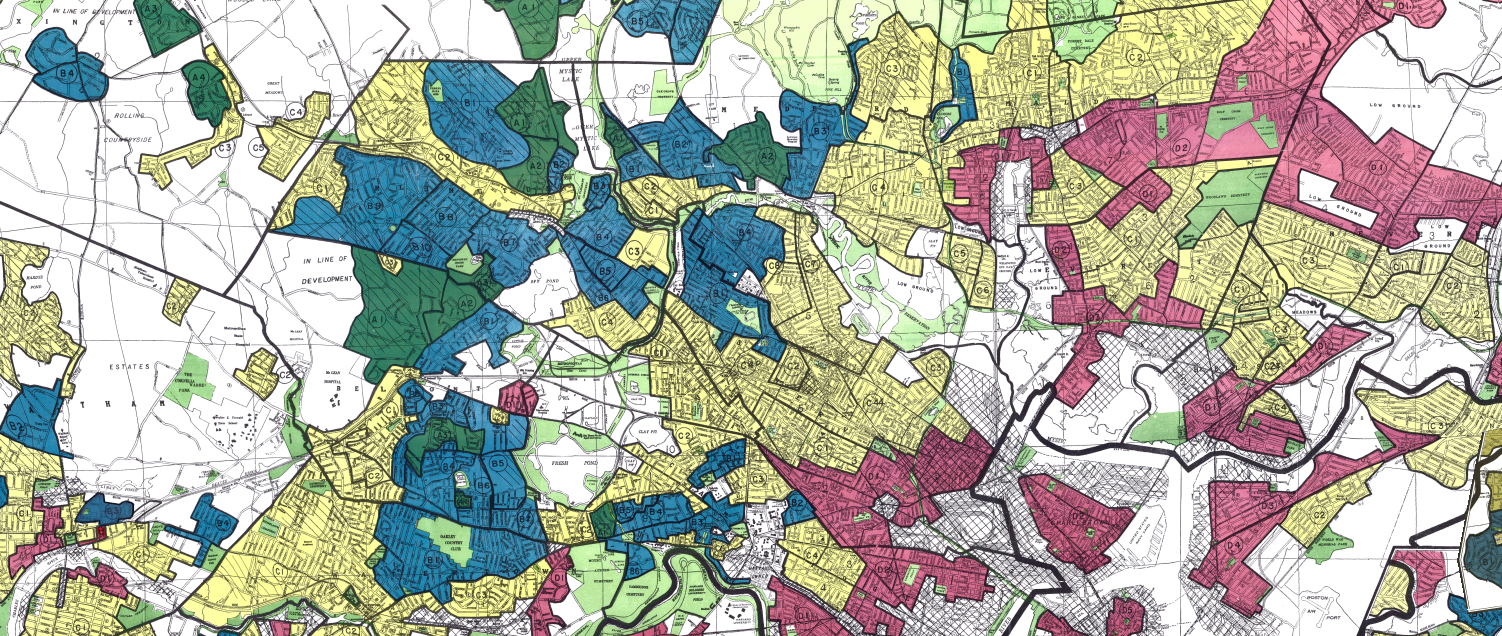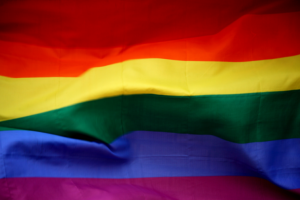BLACK LIVES MATTER
The term ‘redlining’ comes from the practice of government and financial institutions literally drawing red lines on maps around majority Black and brown neighborhoods, designating them as areas where various services would be denied to residents. The practice began with the National Housing Act of 1934, and while redlining formally continued into the 80’s, housing segregation is a persistent problem today.
Redlining is one example of a vast system of inequity, both explicit and unintentional processes that harm communities of color for corporate profit and white privilege. Part of that system is violence and murder committed by the police against Black neighbors. In Kentucky, where Breonna Taylor was murdered by police while in bed, one in four African American adults cannot vote as a result of felony disenfranchisement. This rate of 26.2% is triple the national African American disenfranchisement rate of 7.44%. (Prison Policy, 2020)
As a result of COVID-19, the United States is poised to see an avalanche of evictions. The government shut down parts of the economy, and people lost their jobs. But rent is still due. The few eviction moratoriums that existed are being lifted. People will be kicked out of their homes unless we act now to protect them.
On average, Black renters have evictions filed against them by landlords at nearly twice the rate of white renters. (ACLU, 2020) In April, while white Americans lost jobs due to COVID-19 at a rate of 14.2%, Latino and Black Americans were significantly more likely to lose their jobs: Latino unemployment reached a record high of 18.9 percent, and Black unemployment reached 16.7 percent. (Urban Institute, 2020)
States that have eviction moratoriums must continue them. States that don’t have them need to enact them. But that’s not enough. We need systems and funding to fill the gaps, rental assistance and eviction diversion courts.
In Rhode Island, there is no eviction moratorium. The State began filing evictions from before the quarantine at the start of this month, and it will begin processing COVID-related evictions in July. Eviction Lab has rated RI .38 out of 5 stars on our states policies, and The State only provided rental assistance for a small number of families.
But rental assistance and moratoriums are temporary fixes. New sustained funding for building and operating deed-restricted affordable homes must be created. Rhode Island is the only state in New England that does not have dedicated, sustained funding for affordable housing. Even before the pandemic, Rhode Island had the lowest rental vacancy rate in New England, and its production was down significantly from historical averages.
Below is a list of articles about racism in housing, followed by selected stats pulled from those articles.
RESEARCH /ARTICLES TO LEARN MORE
STRUCTURAL RACISM
The Case for Reparations | The Atlantic | Ta-Nehisi Coates June 1, 2014
Living Apart: How the Government Betrayed a Landmark Civil Rights Law | Propublica | Nikole Hannah-Jones June 25, 2015
Racial Disparities Among Extremely Low-Income Renters | NLIHC | The Gap Apr 15, 2019
Racial Disparities in Home Appreciation | Center for American Progress | Michela Zonta July 15, 2019
Metro areas are still racially segregated | Brookings | Jenny Schuetz December 8, 2017
Another Way to Achieve Racial Justice: Zoning Reform | Planetizen | James Brasuel June 14, 2020
Racial Disparity in Home Lending Is Today’s Redlining | Planetizen | Lee Flannery June 11, 2020
The Unsurprising Reason More Black Americans Are Becoming Homeless | Curbed | Alissa Walker Jun 10, 2020
Racial and ethnic price differentials in the housing market | Science Direct | Patrick Bayer November 2017
Clearing the Record: How Eviction Sealing Laws Can Advance Housing Access for Women of Color | ACLU | Sophie Beiers January 10, 2020
State of Homelessness: A Look at Race and Ethnicity | NAEH | Joy Moses May 27, 2020
A Look At Housing Inequality And Racism In The U.S. | Forbes | Dima Williams June 3, 2020
Does Whiteness Explain Local Land-Use Patterns? | Housing Matters | Jessica Trounstine May 20, 2020
Housing Justice is Racial Justice | NLIHC | Diane Yentel, NLIHC President and CEO Jun 08, 2020
A ‘Forgotten History’ Of How The U.S. Government Segregated America | NPR | Terry Gross May 3, 2017
COVID + HOUSING + RACE
Black community braces for next threat: Mass evictions | Politico | Katy O’Donnell June 16, 2020
How Economic Crises and Sudden Disasters Increase Racial Disparities in Homeownership | Urban Institute | Michael Neal + Alanna McCargo June 2020
New Data Suggest COVID-19 is Widening Housing Disparities by Race and Income | Urban Wire | Alanna McCargo &Solomon Greene May 29, 2020
COVID-19 crisis highlights housing inequality faced by black Americans | Yahoo Finance | Brian Cheung June 3, 2020
Behavioral Health Disparities in Black and Brown Communities: Making the Connection Between COVID-19 and Racism |NAEH | Chandra Crawford June 8, 2020
Systemic racism and coronavirus are killing people of color. Protesting isn’t enough | National Geographic | Ruddy Roye June 4, 2020
It’s getting even harder for black and Latino tenants to pay the rent | CNN | Anna Bahney June 5, 2020
How COVID-19 threatens black homeownership | Housing Wire | Alcynna Lloyd May 18, 2020
‘The housing emergency most harms people of color:’ Black Americans face an unequal housing market — and coronavirus could make it worse | Market Watch | Jacob Passy Jun 3, 2020
The Intersection of Homelessness, Race, and the COVID-19 Crisis | NAEH April 7, 2020
LOOKING FORWARD
To Equitably Connect Housing and Economic Mobility for Black Americans, Tackle Structural Racism | Housing Matters | Janae Ladet February 08, 2018
The Alliance’s Racial Equity Network Action Steps (Tool Kit) | NAEH | February 3, 2020
20th Century African Heritage Civil Rights in Rhode Island | Rhode Island Historical Society
How to Put Racial Equity at the Center of Neighborhood Investment | Housing Matters |Kimberly Burrowes February 19, 2020
Four Ways to Integrate a Structural Racism Lens into Neighborhood Health Research | Housing Matters | Alicia R. Riley May 01, 2019
Black Lives Matter: Solidarity and action | Results.org | Joanne Carter June 2nd, 2020
STATS
STRUCTURAL RACISM
Homeownership is one of the only paths to building wealth for low-income families in the U.S. In 2016, 58% of black household heads and 54% of Hispanic household heads were renting their homes, compared with 28% of whites. | 2016 data from the Pew Research Center
In 2015, 46 percent of African-American-led renter households were rent burdened, compared with 34 percent of white households. Between 2001 and 2015, the gap between the share of white and African- American households experiencing severe rent burden grew by 66 percent. | 2018 Pew
In 2015, according to Pew, less than two-thirds of black and Hispanic households held home loans with rates below 5%. Some 73% of white and 83% of Asian households had such mortgages. | 2020 Forbes
Even African-Americans with similar credit profiles and down-payment ratios to white borrowers were more likely to receive subprime loans, according to the study.As a result, from 1993 to 2000, the share of subprime mortgages going to households in minority neighborhoods rose from 2 to 18 percent,
On average, Black renters had evictions filed against them by landlords at nearly twice the rate of white renters. | 2020 ACLU
Assuming she and her white, non-Hispanic male counterpart begin work at age 20, a Black woman would have to work until she is 86 years old to catch up to what a white, non-Hispanic man has been paid by age 60. Black women working full time, year-round are paid only 61 cents for every dollar paid to their white, non-Hispanic male counterparts. | 2019 National Women’s Law Center
Hispanic homebuyers pay premia of around 2% on average across the four cities — differences not explained by variation in buyer income or access to credit. | 2017 Science Direct
High-poverty neighborhoods are made up of 43% Black, 31% Hispanic, and only 13% White. While low-poverty neighborhoods are made up of 9% Black, 11% Hispanic, and 33% White. Zip code is the strongest indicator of economic mobility and health outcomes. | 2020 NLIHC
Blacks continue to have lower rates of upward mobility than whites. In 2016, the median black and Hispanic worker earned 65% and 63% of the median white worker, respectively. | 2019 NLIHC
When cities are greater than 15 percentage points whiter than the metro area, they are more likely to restrict land use. In addition to whiteness, homeownership and wealth also positively predict land-use restriction. | 2020 Housing Matters
Today African-American incomes on average are about 60 percent of average white incomes. But African-American wealth is about 5 percent of white wealth. Most middle-class families in this country gain their wealth from the equity they have in their homes. So this enormous difference between a 60 percent income ratio and a 5 percent wealth ratio is almost entirely attributable to federal housing policy implemented through the 20th century. | 2017 NPR
African Americans represent thirteen percent of the general population but are forty percent of people experiencing homelessness and more than fifty percent of homeless families with children. Black families are twenty-six percent of all extremely low-income renters. | 2020 NLIHC
COVID + HOMES + RACE
In April, while the white Americans lost jobs due to COVID at a rate of 14.2%, Latino and Black Americans were significantly more likely to lose their jobs: Latino unemployment reached a record high of 18.9 percent, and Black unemployment reached 16.7 percent. | 2020 Urban Institute
About a quarter of Black and Latino renters were not able to pay rent due to COVID in May, compared to 14 percent of white renters. Among people with mortgages, 28 percent of Black homeowners did not pay or deferred their mortgage in May 2020, compared with only 9 percent of white homeowners. | 2020 Urban Institute



